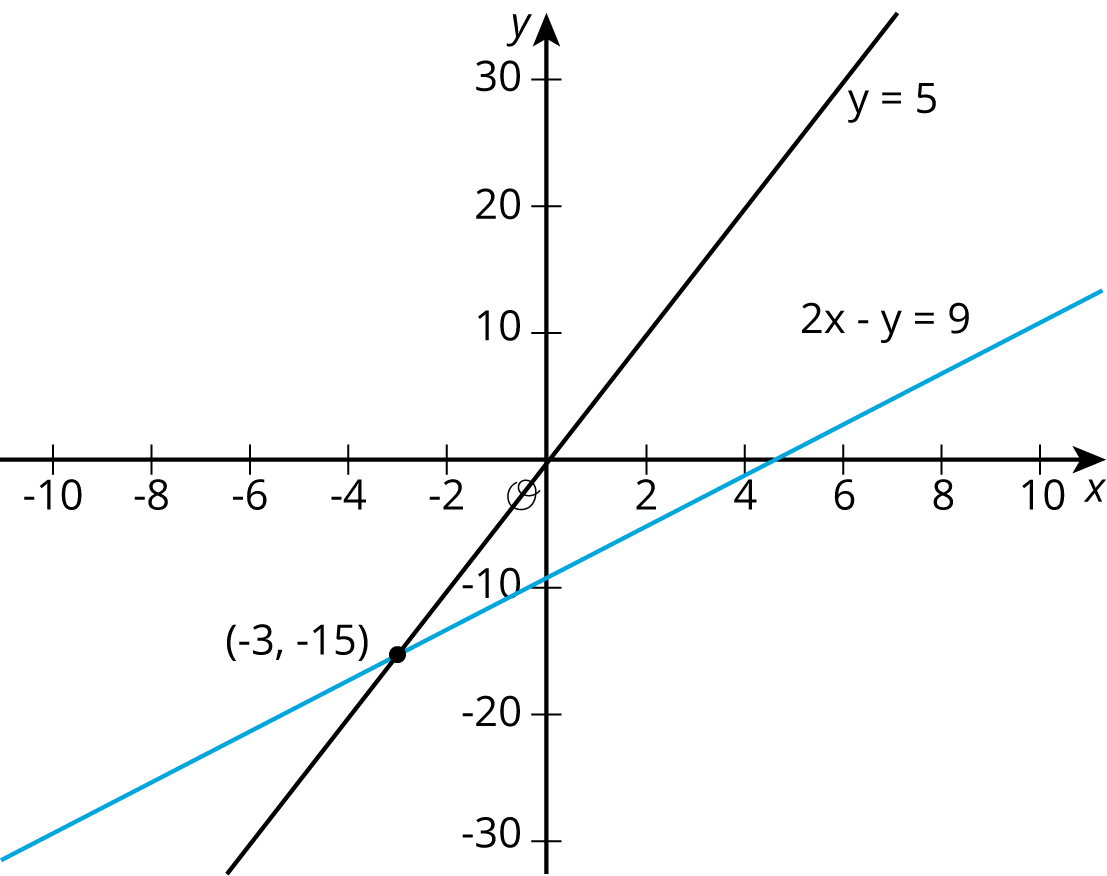14.1: Algebra Talk: Solving Systems Mentally
Solve these without writing anything down:
$$ \begin{cases} x=5\\ y=x-7 \end{cases}$$
$$ \begin{cases} y=4\\ y=x+3 \end{cases}$$
$$ \begin{cases} x=8\\ y=\text-11 \end{cases}$$
Let’s solve systems of equations.
Solve these without writing anything down:
$$ \begin{cases} x=5\\ y=x-7 \end{cases}$$
$$ \begin{cases} y=4\\ y=x+3 \end{cases}$$
$$ \begin{cases} x=8\\ y=\text-11 \end{cases}$$
Here are a lot of systems of equations:
A \(\begin{cases} y= 4 \\ x=\text-5y+6 \end{cases}\)
B \(\begin{cases} y= 7 \\ x=3y-4 \end{cases}\)
C \(\begin{cases} y= \frac{3}{2}x+7 \\ x=\text-4 \end{cases}\)
D \(\begin{cases} y= \text-3x+10 \\ y=\text-2x+6 \end{cases}\)
E \(\begin{cases} y= \text-3x-5 \\ y=4x+30 \end{cases}\)
F \(\begin{cases} y= 3x-2 \\ y=\text-2x+8 \end{cases}\)
G \(\begin{cases} y= 3x \\ x=\text-2y+56 \end{cases}\)
H \(\begin{cases} x=2y-15 \\ y= \text-2x \end{cases}\)
I \(\begin{cases} 3x+4y=10 \\ x=2y \end{cases}\)
J \(\begin{cases} y= 3x+2 \\ 2x+y = 47 \end{cases}\)
K \(\begin{cases} y= \text-2x+5 \\ 2x+3y = 31 \end{cases}\)
L \(\begin{cases} x+y=10 \\ x=2y +1 \end{cases}\)
Tyler was looking at this system of equations:
$$\begin{cases} x + y = 5\\x + y = 7 \end{cases}$$
He said,
“Just looking at the system, I can see it has no solution. If you add two numbers, that sum can’t be equal to two different numbers.”
Do you agree with Tyler?
In rectangle $ABCD$, side $AB$ is 8 centimeters and side $BC$ is 6 centimeters. $F$ is a point on $BC$ and $E$ is a point on $AB$. The area of triangle $DFC$ is 20 square centimeters, and the area of triangle $DEF$ is 16 square centimeters. What is the area of triangle $AED$?
When we have a system of linear equations where one of the equations is of the form $y = \text{[stuff]}$ or $x=\text{[stuff]}$, we can solve it algebraically by using a technique called substitution. The basic idea is to replace a variable with an expression it is equal to (so the expression is like a substitute for the variable). For example, let's start with the system:
$$\begin{cases} y = 5x\\2x - y = 9 \end{cases}$$
Since we know that $y = 5x$, we can substitute $5x$ for $y$ in the equation $2x - y = 9$,
$$2x - (5x) = 9,$$
and then solve the equation for $x$,
We can find $y$ using either equation. Using the first one: $y = 5 \boldcdot \text-3$. So
$$(\text-3,\text -15)$$
is the solution to this system. We can verify this by looking at the graphs of the equations in the system:

Sure enough! They intersect at $(\text-3, \text-15)$.
We didn't know it at the time, but we were actually using substitution in the last lesson as well. In that lesson, we looked at the system
\(\begin{cases} y = 2x + 6 \\ y = \text-3x - 4 \end{cases}\)
and we substituted $2x+6$ for $y$ into the second equation to get $2x+6=\text-3x-4$. Go back and check for yourself!